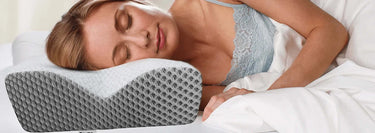Leg Elevation, Alignment &, Posture Support Explained

Leg elevation looks simple at first glance: place a wedge under your legs and relax. In reality, the angle and height you choose can completely change how your body feels during and after a session. A few degrees too steep or too shallow can shift pressure into the lower back, hips, or knees instead of giving them a break.
This page breaks down leg elevation angles in a clear, ergonomic-focused format. The goal is straightforward: give you angle ranges and structure guidelines so you can build a leg elevation routine that feels stable, repeatable, and kind to your posture.
Table of Contents
- 1. Why Leg Elevation Angles Matter More Than People Think
- 2. Key Angle Ranges For Everyday Use
- 3. Height vs. Angle: How They Work Together
- 4. Upward Incline vs. Ergonomic Incline
- 5. Practical Angle & Session Chart
- 6. Applying These Angles With Zen Bloks® Wedges
- 7. Micro-Adjustments: Fine-Tuning Tension & Pressure
- 8. Quick Glossary: Alignment & Angle Terms
- 9. Compliance & Disclaimer
1. Why Leg Elevation Angles Matter More Than People Think
Elevating your legs changes how gravity interacts with your body. When the angle is dialed in, pressure spreads out through the calves, knees, and thighs instead of bunching up in a single hot spot. When the angle is off, small joints end up carrying more load than they should.
 (Above) This diagram highlights the core geometric elements of a leg elevation wedge. The vertical measurement shows the 10-inch elevation height, the angled line illustrates the primary incline, and the curved section marks the apex transition where the slope shifts into the upper platform. These three features define how the wedge shapes alignment and distributes load during elevation.
(Above) This diagram highlights the core geometric elements of a leg elevation wedge. The vertical measurement shows the 10-inch elevation height, the angled line illustrates the primary incline, and the curved section marks the apex transition where the slope shifts into the upper platform. These three features define how the wedge shapes alignment and distributes load during elevation.
A well-designed leg elevation wedge uses a balanced incline to:
- Encourage a neutral pelvis instead of tipping the hips forward or backward.
- Keep the knee bend moderate so the joints feel supported rather than locked.
- Shift body weight into the wedge surface instead of concentrating it into the heels.
- Support a natural spinal curve instead of forcing the low back to flatten aggressively.
Angles do not need to be extreme to be effective. Most people get better results from a stable, ergonomic incline than from a dramatic angle that feels impressive for a few minutes and exhausting later.
2. Key Angle Ranges For Everyday Use

In ergonomic design, leg elevation angles are usually discussed as a range, not a single number. The body is dynamic, and your ideal range depends on height, hip mobility, and how long you plan to stay elevated.
2.1 Short Daily Reset (10–20 Minutes)
For quick breaks after long standing or sitting sessions, an incline in the range of 20°–30° works well for most people. This angle:
- Raises the calves and ankles enough to reduce a sense of heaviness.
- Keep knees gently flexed, not sharply bent.
- Usually feels comfortable even for people new to leg elevation.
This “reset range” pairs well with the guidance from How Long Should You Elevate Your Legs? where the focus is short, consistent sessions instead of one uncomfortable marathon.
2.2 Evening Wind-Down & Screen Time
For a more extended session while watching a show, reading, or scrolling, the body usually prefers a slightly softer incline in the 18°–28° zone.
- A less angle keeps the lower back calmer during longer sessions.
- Thighs rest more evenly, which helps reduce tension across the front of the hips.
- This range pairs well with ergonomic head pillows for side and back sleepers.
Combining a consistent incline with a head pillow that maintains a neutral neck position is especially helpful for people training themselves from side sleeping into more back-friendly positions over time.

(Above) This diagram shows how the lower body follows a continuous alignment path when resting on a properly designed elevation wedge. The blue highlight at the knee bend zone marks where the incline supports the joint transition, while the support line illustrates how the wedge evenly distributes load from the heel to the upper leg to maintain balanced posture throughout the elevation session.
2.3 Extended Elevation While Resting
When the legs remain elevated for much of the evening, subtle adjustments add up. Many users feel best in the 15°–24° range for extended elevation.
- Gentler incline, more surface contact, less local pressure.
- Knees stay bent, but the angle looks more relaxed in photos and in real life.
- The wedge behaves more like a base platform than a “ramp.”
This is where a structured product like the Zen Bloks® leg elevation wedge collection stands out. The design is tuned for repeatable everyday use rather than one-time, high-angle sessions.
3. Height vs. Angle: How They Work Together

Angle and height are two sides of the same story. The same 10-inch wedge feels entirely different for someone who is 5'2" than to someone who is 6'2". That is why we separate:
- Elevation height — how high the knees and calves sit above the mattress or sofa.
- Incline angle — how sharply the wedge rises from heel to knee.

(Above) This diagram shows how a well-designed elevation wedge maintains a consistent incline within a defined tolerance band. The red line represents the ideal angle, while the two blue lines mark the upper and lower limits that still support balanced leg alignment. The arrows on the lower image illustrate how the body naturally follows this incline, keeping the alignment path stable across different resting positions.
You already have a dedicated sizing breakdown on Leg Elevation Height by Body Size. This page connects that sizing logic to how the body actually feels on the incline.
3.1 Matching Elevation To Body Size
In general terms:
- Shorter bodies reach a steeper angle with the same height, so they often prefer slightly lower wedges for long sessions.
- Taller bodies need more height to achieve a meaningful angle; otherwise, the legs feel “almost flat,” and the session loses impact.
- Borderline heights (for example, 5'7"–5'8") can often use either size and choose based on hip and knee comfort.
This is exactly why Zen Bloks® offers different wedge heights with the same patented ergonomic profile. The contour stays consistent; only the elevation changes.

(Above) This diagram illustrates how the wedge’s incline follows a defined ergonomic angle from base to apex. The dashed lines show slight variations in the ideal angle that still maintain a functional support profile, while the solid path represents the intended incline used in the product’s design. This visual highlights how consistent angle geometry guides lower-body alignment during elevation.
3.2 Hip and Knee Geometry In Real Life
From a simple geometry standpoint:
- If the knee angle is too tight, the back of the leg may feel compressed over time.
- If the hip angle opens too far, the lower back can arch more aggressively into the mattress.
- The sweet spot sits where the thighs rest into the wedge without the pelvis tipping strongly forward or back.
You can see this neutral alignment visually in the photos on the Back & Side Sleeper Alignment guide, where the wedge height and angle keep everything stacked in a calm, balanced way.
4. Upward Incline vs. Ergonomic Incline
Not all leg elevation is structured the same way. It helps to separate two concepts:
- Upward incline — any position where the feet are higher than the hips for a short window of time.
- Ergonomic incline — a measured, repeatable angle tuned for daily use, alignment, and long-term comfort.
An upward incline can be dramatic and still acceptable for a few minutes, especially if someone is experimenting with different positions. An ergonomic incline aims for consistency. It respects the load on the knees and hips, the relationship between leg height and back position, and how the body feels after many evenings of use, not just one.
Zen Bloks® wedges sit firmly in the ergonomic category: a structured base, intentional knee curve, and a controlled angle that favors posture and daily recovery habits.
![]()
5. Practical Angle & Session Chart
The table below shows typical angle ranges that pair well with real-world use cases. These are lifestyle guidelines, not rules, and they work best alongside the deeper sizing guidance in your other Leg Elevation Guide pages.
| Use Case | Approx. Angle Range | Session Length | Primary Focus |
|---|---|---|---|
| Quick daily reset after standing or sitting | 20°–30° | 10–20 minutes | Lightness in the legs, simple posture break |
| Evening wind-down while reading or watching a show | 18°–28° | 20–45 minutes | Balanced back comfort, reduced lower body tension |
| Extended elevation during rest | 15°–24° | 45–90 minutes (with small adjustments) | Even pressure distribution, sustainable posture |
| Short, steeper incline experiment | 30°+ | 5–10 minutes | Occasional variation only, not a daily baseline |
6. Applying These Angles With Zen Bloks® Wedges
Zen Bloks® wedges are built around a structured incline that fits naturally into the ranges above. Instead of chasing a single “perfect angle,” the design gives you a stable base that works across multiple routines:

- Short resets after long drives or desk sessions.
- Consistent evening habits for screen time or reading.
- Longer rest blocks where posture and alignment need to stay calm.
If you are still deciding on height, pair this page with:
- Leg Elevation Height by Body Size — to choose between different wedge heights.
- Leg Elevation Benefits for Daily Reset & Everyday Comfort — to see how angle, timing, and routine work together.
- Leg Elevation Mistakes to Avoid — to avoid common habits that create extra stiffness or strain.
7. Micro-Adjustments: Fine-Tuning Tension & Pressure
Even within an ideal angle range, details still matter. Two people on the same wedge can feel very different things depending on how they place their feet or where the calves land.
Simple micro-adjustments that make a big difference:
- Shift the calves slightly higher or lower on the wedge to change how strongly the knees bend.
- Slide the body a few centimeters up or down the mattress to let the lower back settle into a comfortable curve.
- Adjust foot position (toes gently forward vs slightly flexed) to change how the back of the legs engage with the surface.
- Pair with an ergonomic head pillow so the neck and upper back follow the same alignment logic as the lower body.
Small movements like these keep tension from building up in one area. The goal is not to lie motionless, but to stay within a supportive angle range while giving your body permission to settle.
8. Quick Glossary: Alignment & Angle Terms
- Ergonomic incline
- An elevation angle chosen for everyday use, balancing comfort, posture, and long-term sustainability instead of short-term extremes.
- Neutral spine
- A natural S-shaped curve of the spine where the back feels supported without being forced flat or arched aggressively.
- Neutral pelvis
- A position where the hips are not strongly tilted forward or backward, allowing the lower back to stay calm on the mattress or sofa.
- Elevation height
- The vertical distance between the resting surface and the highest part of the legs when elevated on a wedge.
- Structured support
- A repeatable support surface that holds its form over time, guiding the body into the same reliable position each session.
9. Compliance & Disclaimer
The information on this page focuses on ergonomic positioning, lifestyle comfort, and everyday posture alignment. It is not a substitute for guidance from a qualified health professional and is not intended to address specific ailments or conditions.
Zen Bloks® products are comfort and support items, not medical devices, and are not intended to diagnose, treat, cure, or prevent any disease.





